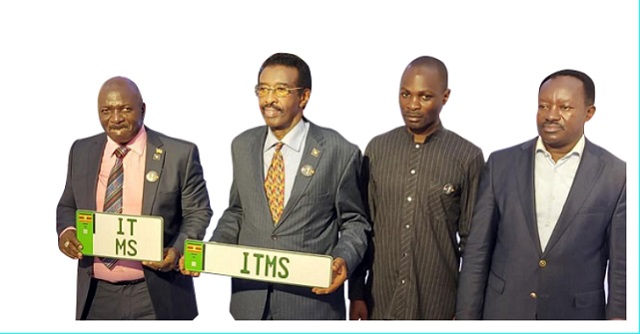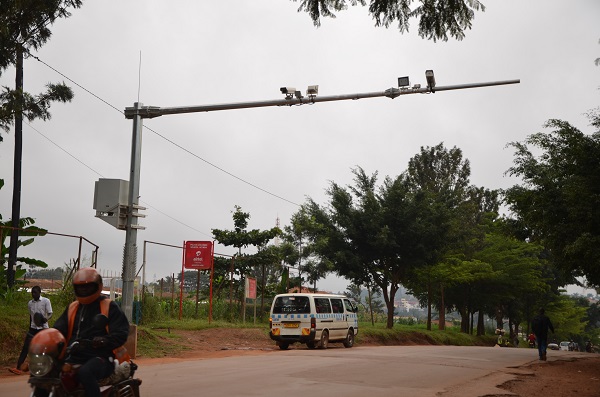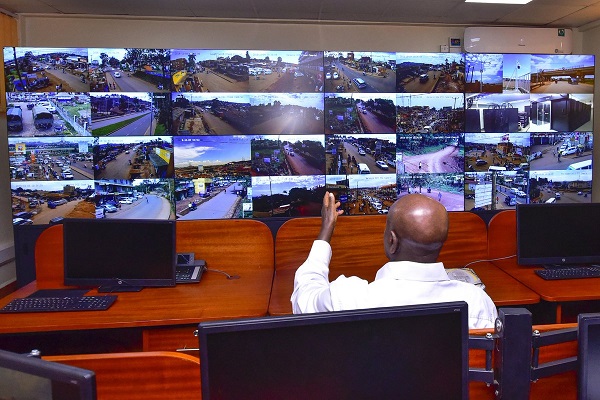
Why is security scheme being promoted as transport project?
COVER STORY | THE INDEPENDENT | The new vehicle number project is pushing ahead despite opposition from many quarters, including at the highest level of government; in the cabinet.
On Nov. 01, the Minister for Security, Maj. Gen. Jim Muhwezi flanked by the Minister of Works and Transport, Gen. Katumba Wamala held a demo for journalists to show what the new number plates for government vehicles would look like and what the process of installing them would be like.
The two ministers said the demo was the official launch of the project but sources familiar with it told The Independent that the project is far from the launch stage. In fact, at the event, the ministers admitted the “bonded warehouses” where the fitting would be done are still being set-up and are not ready.
Equally missing were details of what makes the new numbers digital or even basically electronic. The question arose because the ministers were mean on details of what the new number plate project is about.
The number plate is the same old metallic sheet. It is not clear what features the new so-called digital number plates Jim Muhwezi is introducing will have as the features are shrouded in secrecy.
“These license plates will have characteristics that enable law enforcement organisations to precisely and quickly identify both vehicles and their owners,” the project implementers say on the official website of the Intelligent Transport Monitoring System (ITMS). There is no other detail.
Labelling the new number plate as a “system” as implied in the Intelligent Transport Monitoring System (ITMS) designation of the project is equally misleading according to experts that spoke to The Independent.
Typically, Intelligent Transportation Systems (ITS) must have a structured Data centre or a Cloud that provides information processing capability for consumption and action by road users and project implementers. That means the vehicles involved in the ITS must be fitted with equipment to both emit and receive necessary information.
There was initially talk of embedded Bluetooth chips in the number plates and each vehicle getting a new unique identification code. Instead it appears, the monitoring and tracking will be based on the old CCTV camera network of the police. In other words, there is no new system as is claimed by the implementers.
Typically, digital number plates use RFID (radio frequency identification) tagging which stores some information such as a record of the vehicles’ journeys and taxes, fees, and penalties and accident history etcetera.
But Muhwezi’s number plate is only digital to the extent that it has an attached Global Positioning System (GPS) device that uses digital systems to track the geographic position of the vehicle. Most mobile phones have GPS trackers. Unless, of course, other digital or electronic devices will be installed without the vehicle owners’ knowledge. That is possibly why vehicle owners will be required to take their vehicles to designated “bonded ware houses.
The Kenya government in August 2022 launched similar so-called digital number plates. The Kenyan government did not demand that vehicle owners take them to “bonded warehouses” for fitting.
In Kenya, the new plates are fitted on all imported vehicles at the point of entry, but owners of already registered vehicles have to apply online to the National Transport and Safety Authority (NTSA) for the new plates. When the plates are ready, the NTSA notifies the vehicle owner to pick them and fit them at their convenience.
If the purpose of holding every vehicle by Uganda officials is not to install secret devices then it is possibly another money making venture. But the money-making won’t last long because it will impose high maintenance and replacement on vehicle owners in case of unintentional damage in accidents. There is also the common crime of number plate theft for ransoms. All these will make the process of keeping vehicles in “bonded warehouses” costly, cumbersome, and unsustainable.
Extension of `smart city’ concept?
Of course Kenya and Uganda are possibly pursuing the same ends with the installation of the new number plates on vehicles. The major difference is how the two governments are promoting the new number plates.
In Kenya, the number plates were introduced as part of measures to fight forgery of number plates and swapping and duplicating them which are common crimes there as in Uganda. That is possibly why the project was squarely under the National Transport and Safety Authority (NTSA) under the Ministry of Roads and Transport. The new number plates were promoted as an addition to making Kenyan cities “safe cities.”

It is the same arrangement which has seen Nairobi become one of the most surveilled places in Africa. According to the BBC, communication networks from Huawei link 1,800 surveillance cameras with 195 police stations and 7,600 police officers in Nairobi.
It says the Kenyan government has invested in the high-speed private broadband network and its National Police Service Commission has linked command centres with over 1,500 high-definition cameras in downtown Nairobi, as well as 200 cameras at checkpoints and wireless devices of field officers.
Nairobi is equipped with panoramic video surveillance and a highly-agile command and dispatch setup, running on satellite-based GPS and software-based GIS. Managing all the video data efficiently, an intelligent video analysis platform was installed, including real-time surveillance, video browsing, data sharing, and evidence collection. All this is not unusual. Most places around the world employ these Video Surveillance as a Service (VSaaS) technologies.
Even London, for example, is the ninth most surveilled city in the world with over 127,000 public CCTV cameras. That equates to more than 13 cameras per 1,000 people. By transforming existing video security systems, VSaaS platforms are essential for cities looking to become smarter without requiring extortionate budgets.
Uganda also rolled out the same “safe city” technology. But it soon ran into mud when an American newspaper, The Wall Street Journal, reported that the implementers; Huawei, had enabled the government security operatives to spy on their political opponents, including the leader of the National Unity Platform (NUP), Robert Kyagulanyi aka Bobi Wine.
The installation of CCTV cameras in Kampala started in July 2019 after President Museveni directed a kick off of the project following the murder of the Assistant Inspector General of Police, Felix Kaweesi in 2017.
In August 2019, the Uganda Police Force announced it had purchased facial recognition cameras from the company at a cost of US$126 million as part of a ‘Safe City’ agreement.
As part of the safe city project, Uganda installed Huawei supplied closed-circuit television cameras that have facial recognition software to identify people with remarkable accuracy. The system is located at the police headquarters in Naguru, equipped with 83 monitoring centres, 522 operators and 50 commanders, according to some reports.
Huawei’s safe city technology has been rolled out in more than 230 cities around the world. The Chinese company spins its facial recognition technology as a way to detect and deter criminals and solve crime cases.
According to Quartz, Huawei says that its safe city technology in Kenya was used in 2015 when Pope Francis visited the country ensuring that in a 0.12-square-kilometre place with more than 300,000 people and 10,000 police officers, there were zero incidents and complaints.
But Quartz says privacy advocates worry about a darker side to facial recognition technology and other artificial intelligence software that can be exploited by corrupt governments and police departments to quash individual freedom. The main difference is what each government sets up the VSaaS technologies for. Is it in the interest of the citizens or not?
The new number plates in Kenya have a Quick Response (QR) code which allows storage of data and its quick accessibility when scanned. Other features include a National Transport and Safety Authority (NTSA) serial number, the country flag, and a hologram. The number plate also has a microchip that contains all of the vehicle’s information, such as ownership, colour, year of manufacture, vehicle type, chassis number, and so on.
Questions of cost
In Kenya, the new plates are fitted on all imported vehicles at the point of entry, but owners of already registered vehicles have to apply for the new plates. The cost is Kshs3000 (Approx. US$20) for vehicles and KShs1500 for motorcycles.
The new Ugandan numbers plates will cost Shs714,000 (Approx. US$190) per new vehicle or motorbike. Replacement number plates on already registered vehicles will cost Shs150,000 (US$40) for vehicles and Shs50,000 (US$14) for motorcycles.
In effect, the new number plate project is a security project. It is not clear what features are on the new Uganda number plates. But, it appears, the objective of Muhwezi’s project is to enable security operatives to instantly identify a vehicle, and if they choose, monitor or track it.
The agreement signed July 23, 2021 between the Government of Uganda and M/S Joint Stock Company Global Security was for provision of a digital “monitoring and tracking system through a real time control and monitoring centre.”
Experts familiar with the project say it is not clear how installing a GPS device on a number plate transforms it into a real time monitoring and tracking “system.”
But in a bubble of unnecessary noise, government officials are promoting the project as a transport improvement project. That is why it is called the Intelligent Transport Monitoring System (ITMS). In cities with ITMS, the main function is to control traffic flow by enabling direction and redirection of traffic flow based on ambient factors.
Muhwezi’s ITMS is being promoted as primarily designed to quickly and accurately map all vehicles in an area “should a crime occur.” It is also being promoted as capable of creating hundreds of jobs, possibly 1,000 new jobs both at the domestic production site and the existing fitting facilities spread across the nation. It is also being sold as a project to “reshape vehicle security and criminal control in the country.”
That is why it is intriguing that its implementers and the government are asking the public to pay out-of-pocket to allow government to track and monitor their movements. This is a service that most vehicle owners are not interested to have.

Opposition to the new number plate project is so solid to the extent that Gen. Muhwezi, who signed the contract between the government and a Russian company to install digital monitoring systems in all motorcycles and vehicles, has sought to shield himself behind President Yoweri Museveni.
Muhwezi in August 2021 told parliament that procurement of the company started five years ago; long before his appointment as Security Minister. He said President Museveni gave him the directive on June 13, 2021, before he was even sworn-in as a Minister.
At the time when he presented a personal statement on the floor of parliament, Muhwezi said he was facing public attacks, especially on social media for signing a contract with an allegedly bankrupt company. At the time, Joint Stock Company Global Security, was facing bankruptcy litigations in Russia, and more than a dozen other debt-related litigations.
Muhwezi said that before the award of the contract, the government sent a team to conduct due diligence in December 2018 and the Attorney General, Kiryowa Kiwanuka, said that his office approved the contract.
Joint Stock Company Global Security was sued by LLC “Rus Prom-Technologies,” another Russian company that wants it declared bankrupt. The case was filed in the Arbitration Court of the City of Moscow on September 17, 2020 and accepted on October 20, 2020. Though the case was accepted for hearing, the hearing sessions have been postponed several times as Global Security fights to pay the debt it owes Rus-Prom-Technology.
In another case filed in March 2019, Rus-Prom-Technology had sued Global Security for failure to pay 16.6 million rubles and Rus-Prom-Technology won the case.
Global Security has also been sued by Limited Liability Partnership “Orken Alem” for a debt of 8.5 million rubles and Gu Main Department of the Pension Fund of the Russian Federation for failure to pay 10,000 rubles and 455,000 rubles. All these cases were filed between 2019 and July 2021.
But in August this year, the Minister for Internal Affairs, Maj. Gen, (Rtd) Kahinda Otafiire, told a parliamentary committee that he has no knowledge of the company, Joint Stock Company Global Security that is issuing the digital number plates in Uganda.
Although the police, which Otafiire oversees, is heavily entangled in the project, he said he knew nothing about the project.
“This thing started in 2019, I am just a cog in the whole machine. I do not know who is doing what. What is disappointing is that the Police who would have been the principal actor was largely kept out,” he added.
Otafiire also told the committee that a team he assigned to carry out due diligence on the Joint Stock Company Global Security and its station in Russia returned empty-handed.
“The team brought back a report and informed me that there were no digital number plate manufacturing companies in Russia and that such a service is only being provided in Poland,” he told the Committee.
But a few days later, in September, President Yoweri Museveni insisted the project will go on.
“Now, I’m insisting on the issue of electronic number plates,” Museveni said at a function at the Kololo Ceremonial Ground in Kampala where Cadet Assistant Superintendents of Prisons, Cadet Principal Officers, and Recruit Warders and Wardresses were commissioned.
Regulatory framework needed
According to some reports, there are 12 ‘Safe City’ programmes in sub-Saharan Africa, including in Uganda, Kenya and South Africa, according to the Center for Strategic and International Studies (CSIS), a think tank based in Washington DC.
Eight of the 12 initiatives in Africa are in countries deemed “partly free” and “not free” by Freedom House and globally, just 29% of all ‘Safe City’ initiatives are in countries regarded as “free,” according to CSIS.
“Huawei’s Safe City initiative undoubtedly threatens human rights in Uganda, including the right to peaceful assembly and association as the country prepares for [the] 2021 general elections,” said Dorothy Mukasa, CEO of Unwanted Witness, a Ugandan digital rights advocacy organisation in the Quartz report.
“This is an extension of China’s surveillance apparatus into Uganda through (the) Ugandan Police force, an agency with a track record of brutalizing journalists and opposition politicians,” Mukasa added in 2020.
“In Africa, many countries are still grappling with the fundamentals of privacy and data protection,” says Juliet Nanfuka of the digital rights advocacy organisation, the Collaboration on International ICT Policy for East and Southern Africa (CIPESA).
This has led to “many gaps which question the extent to which national security or state surveillance programmes of individuals are proportionate, fair, and in compliance with international norms and standards,” Nanfuka continued.
To ensure that human rights are protected, Nanfuka said that more effective policy, legal and regulatory frameworks were needed.
Without this, “the apprehension around facial recognition surveillance, despite being termed as “smart cities” or “safe cities” will remain, particularly in states which have a poor human rights track record,” Nanfuka said.
 The Independent Uganda: You get the Truth we Pay the Price
The Independent Uganda: You get the Truth we Pay the Price



This is in fact” another money making venture”. Its a scam of another high level. Time will tell. All these scammers will be brought to light one of these good days. Wait and see how God will expose them.
Shame
The digital number plates will finally be introduced whether today or in future. The reason is because it’s a global plan to set up smart cities where every vehicle and motorcycle will be tracked.